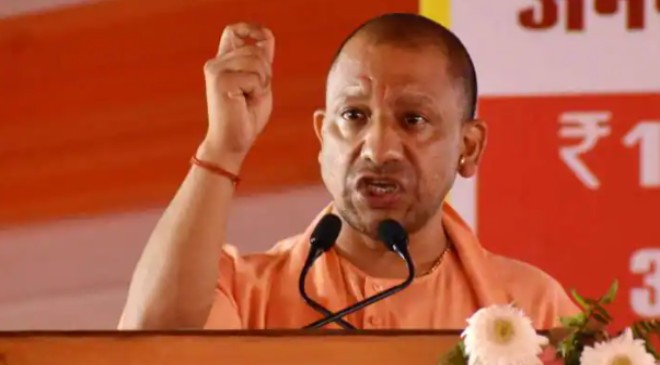A day after being sworn in as chief minister of Uttar Pradesh for a second successive term, Yogi Adityanath directed officials on March 26 to prepare a blueprint detailing how the state can achieve its target of becoming a $1 trillion economy.
“The roadmap for the future should be prepared with teamwork and inter-departmental coordination. For this work, ‘Team UP’ will have to be engaged with full commitment. To make the state’s economy $1 trillion, 10 primary sectors should be identified,” news agency ANI quoted Adityanath as saying.
Days ahead of the swearing-in ceremony, the state government reinitiated efforts to appoint a consultant to suggest measures to achieve the target by 2027.
Last year in March, a similar tender seeking a consultant to boost the size of the UP economy to that level by 2025 was cancelled. The five-year target has now shifted from 2020-25 to 2022-27.
Target set by PM Modi in 2018
The trillion-dollar economy target for Uttar Pradesh was suggested by Prime Minister Narendra Modi when he inaugurated the UP Investors’ Summit in Lucknow on February 21, 2018.
“Can Maharashtra and Uttar Pradesh compete with each other to become a trillion-dollar economy? Will the UP government compete with other states? More the competition, more will be the investment,” the PM said.
The PM’s observation set the ball rolling and the state government began holding discussions to prepare a roadmap. The UP government floated a tender on June 19, 2020, came up with a revised request for proposal (RFP) on October 9, 2020 and decided to hire a consultant with 2020-2025 as the timeline for achieving the target.
At least eight firms, including Deloitte, Boston Consulting Group, Indian Institute of Management-Lucknow and Grant Thornton, submitted bids, according to reports. But after opening the financial bids, the state government decided to cancel the process on March 22, 2021.
The Adityanath government is now planning to meet the target by 2027, and recently published an advertisement seeking to engage a new consultant for the purpose.
A consultant can be “any training and research institutes or universities or consulting firms or government departments or subject matter specialists or entity or person or associations of person that may provide or provides the services” to the government’s planning department, the RFP document said.
The scope of work
The consultant will have its work cut out. The government has divided the scope of work into five categories—understanding the status of the economy, developing the strategic framework, creating an implementation roadmap, designing institutional reforms and developing a monitoring, learning and evaluation framework.
Among other things, the consultant will carry out a critical analysis of macro and micro-economic sectoral data around the Gross State Domestic Product (GSDP), trade, investment, expenditure, savings, workforce participation, inflation, imports and exports in the state for 2016-17, 2017-18, 2018-19, 2019-20, 2020-21 and 2021- 22(E) based on data from government and credible institutional sources.
The analysis should include all key sectors, including agriculture, infrastructure, rural development, education and tourism, to name a few. Additionally, key factors that have contributed to each sector’s growth in the last four years have to be identified, together with how these factors were aided by central and state policies.
The consultant will also have to compare the structural, financial and governance reforms and outcomes achieved in the top three states in India and top three countries across the globe with similarities to Uttar Pradesh.
Based on the present status and recent trends, the consultant needs to determine multipliers between sectoral growth and impact on GSDP, assign targets for each sector and spell out how it can achieve the goal to propel UP towards becoming a $1 trillion economy.
A Herculean task
The UP government’s target is in line with the Centre’s efforts to make India a $5 trillion economy. Uttar Pradesh, the most populous state, will play a critical in India achieving the target.
Uttar Pradesh contributes 8 percent of the national GDP. The state’s GSDP was Rs 17.06 lakh crore in 2020-21, up from Rs 16.88 lakh crore in 2019-20. The state needs to boost the size of GSDP by four-five times to reach the target of becoming a $1 trillion economy by 2027, discounting for exchange-rate fluctuations and global trends, according to the terms of reference in the RFP document.
“This Herculean task demands some giant steps to be taken by the state government to move forward. It needs some well-thought out and long-term strategies on a sustained basis. This would also require organisational restructuring, focused policies and rules for more effective governance, faster decision-making process and improved accountability,” reads the document.
Some experts said it is highly improbable, if not impossible, that the target will be achieved. According to data from the Directorate of Economic and Statistics of the UP government (UPDES), the advance estimates for GSDP for 2021-22 stand at Rs 19.10 lakh crore, says Dr Yashvir Tyagi, former head of the economics department at Lucknow University.”If you translate it into dollars, even if you take a conservative value of Rs 75 to a dollar, the size will be $254 billion and you have to take this to $1,000 billion ($1 trillion), that is four times, in the next five years,” he told





































